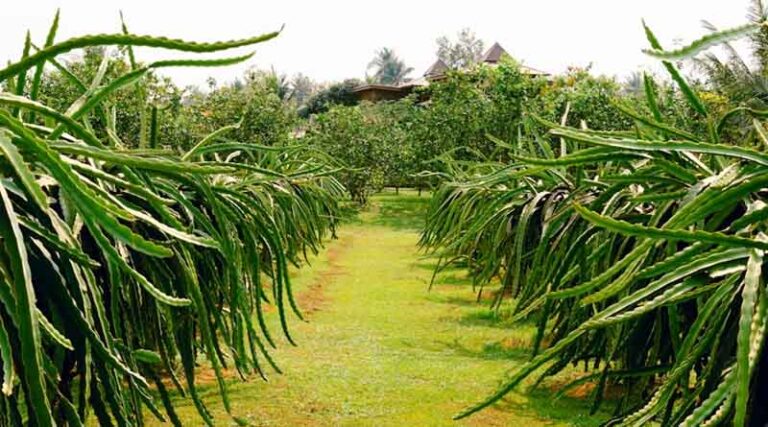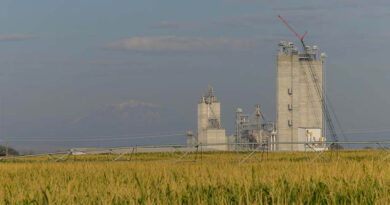
Managing Dragon Fruit During Indian Winters: A Practical and Scientific Approach
08 October 2025, New Delhi: Dragon fruit (Hylocereus undatus) has become an important emerging fruit crop in India due to its high economic return, export potential, and ability to thrive in semi-arid conditions. However, being a tropical cactus, it is sensitive to prolonged low temperatures. In most parts of northern and central India, winter brings minimum temperatures below 10°C, which can slow growth, damage stems, and reduce fruiting in the following season. For farmers investing heavily in this crop, managing the orchard through the winter months is crucial to ensure plant survival and sustained productivity.
Creating a Protective Microclimate
The health of dragon fruit plants during winter depends greatly on maintaining a favorable temperature around them. The ideal range for growth is between 20°C and 35°C, and the plants start showing stress when the temperature dips below 5°C. Farmers can use locally available materials to create a protective microclimate. Transparent polyethylene sheets stretched over bamboo or iron frames can serve as low-cost tunnels or semi-covered structures. These covers trap heat during the day and reduce radiative heat loss at night. The sides should not be completely sealed — ventilation must be allowed during the day to prevent humidity buildup and fungal growth.
In regions where frost occurs, farmers should take additional care by lighting small organic fires (for example, burning dry biomass or husk in a controlled manner) upwind of the orchard to raise ambient temperature slightly on nights of expected frost. Applying dry organic mulch such as straw or sugarcane trash around the plant base further stabilizes soil temperature. The mulch layer should be 6–8 cm thick and should not touch the stem directly, as trapped moisture near the stem may cause rot.
Irrigation and Soil Moisture Balance
Dragon fruit is a succulent crop and needs minimal irrigation in winter because its metabolic activity is reduced. Excessive watering during low temperature conditions often causes fungal diseases like Phytophthora and Fusarium root rot. Before each irrigation, farmers should physically check the soil moisture — if the upper 5–7 cm feels moist, watering can be postponed. Irrigation through a drip system is most effective during this period. A light watering once every 10–15 days is usually adequate for established orchards in central India. Water should be applied during late morning hours when the soil is warmer, never during the evening or night.
It is advisable to avoid standing water anywhere near the root zone, as cold, wet soil causes root suffocation. The water source should be clean and of moderate temperature; very cold water from bore wells can cause temperature shock. Mixing water from a storage tank exposed to sunlight with bore well water before irrigation helps moderate its temperature.
Pruning and Canopy Maintenance
Proper pruning before the onset of winter improves air circulation, light penetration, and reduces disease risk. Farmers should remove any dead, damaged, or diseased stems by cutting them close to the junction with healthy tissue using disinfected pruning shears. The cut surface can be dabbed with a paste of copper oxychloride or a mixture of neem oil and lime to prevent fungal entry. Overcrowded or overlapping branches that shade each other should also be removed to allow sunlight to reach the interior canopy.
During the coldest months, heavy pruning should be avoided. Plants heal slowly in low temperatures, and exposed wounds may become infection sites. Only light pruning or removal of visibly infected parts should be done in mid-winter. Once temperatures begin to rise in February or March, a more thorough shaping can be carried out. Farmers should always sterilize their pruning tools after each plant using a mild bleach or alcohol solution to prevent the spread of pathogens.
Nutrition and Fertilizer Management
In winter, dragon fruit plants enter a semi-dormant phase and have reduced nutrient uptake. Applying high-nitrogen fertilizers during this time promotes soft tissue growth that is vulnerable to cold injury. Instead, farmers should rely on slow-release or organic sources. A dose of about five kilograms of well-decomposed farmyard manure and one kilogram of vermicompost per plant, applied around the root zone in November, provides adequate nutrition throughout the winter.
To strengthen cell walls and increase cold tolerance, a low-dose potassic fertilizer (such as 50–60 g of muriate of potash per plant) can be given with irrigation water. Foliar application of 0.2% potassium nitrate once a month improves stress resistance. Zinc and boron sprays also support tissue healing and prevent tip dieback, especially when plants face low temperature stress. Farmers should not apply fresh organic manure or nitrogen-rich compost in the middle of winter, as it increases microbial activity and lowers soil oxygen in already cool, moist conditions.
Pest and Disease Surveillance
Although pest pressure generally declines in cold weather, dragon fruit plants remain susceptible to fungal and bacterial infections, particularly when humidity stays high under protective covers. Farmers should inspect plants every 10–12 days for early signs of problems. Dark brown patches or soft, water-soaked lesions on the stems indicate stem rot caused by Botryosphaeria or Fusarium. These infected sections should be removed immediately and burnt outside the field.
Small round spots with yellow halos may signal anthracnose infection, which can be controlled by spraying copper oxychloride (0.3%) or mancozeb (0.25%) after pruning. Mealybugs and aphids occasionally appear during warm spells in winter, often near the base of new shoots. Their presence can be detected by sticky honeydew deposits or ants moving on the stems. Farmers can wipe them with a cloth soaked in neem oil or spray 2% neem oil solution once every two weeks. Maintaining good field hygiene, removing weeds around the base, and ensuring drainage helps keep the orchard clean and disease-free.
Light Exposure and Field Cleanliness
Dragon fruit requires full sunlight even in winter. Any shading caused by trees, tall crops, or structures reduces photosynthesis and makes stems soft and pale. Farmers should ensure at least six hours of direct light daily. During foggy periods, removing covers for a few hours during midday allows the plants to absorb light and dry naturally, preventing fungal buildup. Cleanliness of the orchard is as important as protection — fallen fruits, pruned stems, and decaying organic matter should be removed from the field to avoid disease carryover.
Preparing for the Next Growth Cycle
As the weather begins to warm toward February and March, farmers should gradually remove protective covers to allow the plants to acclimatize to open conditions. Irrigation frequency can be increased slightly as new buds begin to swell. At this time, a balanced nutrient spray containing NPK (19:19:19) and micronutrients encourages new vegetative growth. The plants pruned and maintained properly during winter will respond more vigorously when the growing season resumes, leading to uniform flowering and better fruit set.
Dragon fruit cultivation has proven to be a profitable venture for Indian farmers, but winter months can determine the success of the entire year’s crop. A well-managed orchard—protected from frost, maintained with proper pruning, balanced nutrition, clean irrigation, and regular inspection—will not only survive the cold but also emerge stronger and more productive for the next season.
📢 If You’re in Agriculture, Make Sure the Right People Hear Your Story.
From product launches to strategic announcements, Global Agriculture offers unmatched visibility across international agri-business markets. Connect with us at pr@global-agriculture.com to explore editorial and advertising opportunities that reach the right audience, worldwide.






